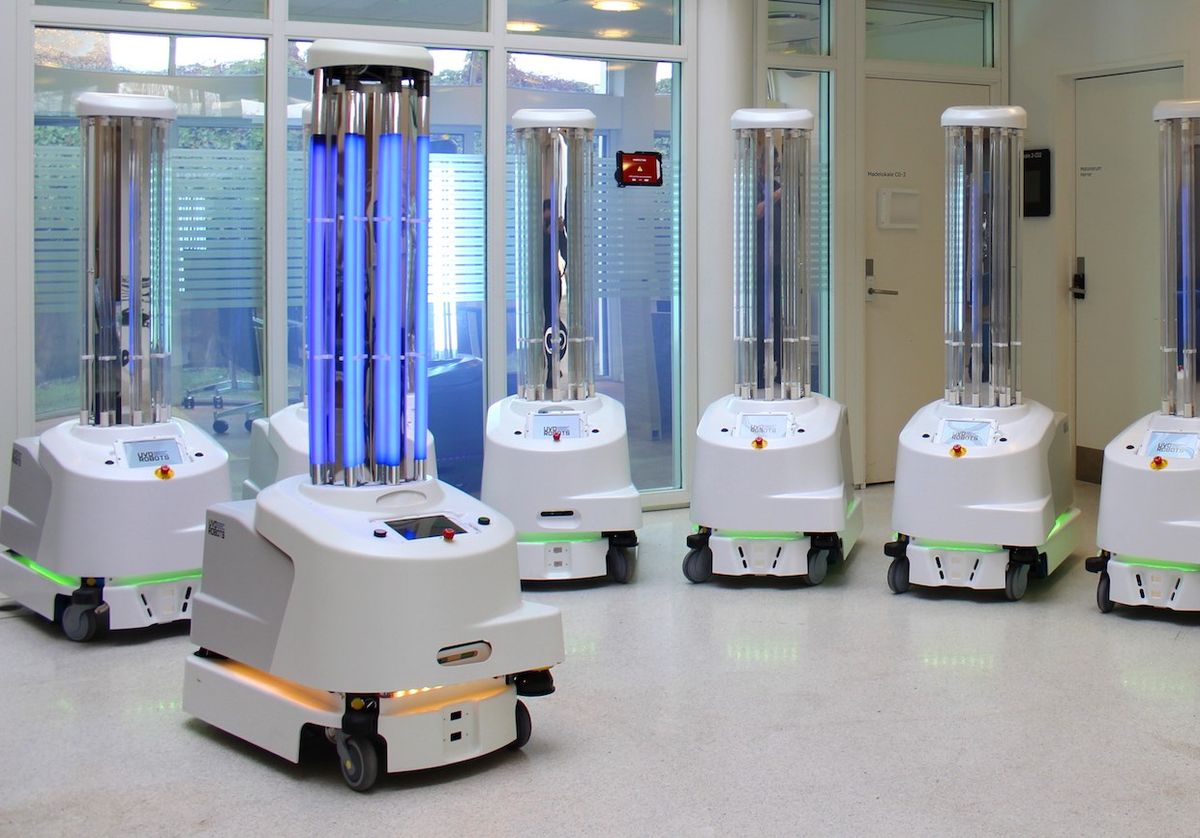The absolute best way of dealing with the coronavirus pandemic is to just not get coronavirus in the first place. By now, you’ve (hopefully) had all of the strategies for doing this drilled into your skull—wash your hands, keep away from large groups of people, wash your hands, stay home when sick, wash your hands, avoid travel when possible, and please, please wash your hands.
At the top of the list of the places to avoid right now are hospitals, because that’s where all the really sick people go. But for healthcare workers, and the sick people themselves, there’s really no other option. To prevent the spread of coronavirus (and everything else) through hospitals, keeping surfaces disinfected is incredibly important, but it’s also dirty, dull, and (considering what you can get infected with) dangerous. And that’s why it’s an ideal task for autonomous robots.

UVD Robots is a Danish company making robots that are able to disinfect patient rooms and operating theaters in hospitals. They’re able to disinfect pretty much anything you point them at—each robot is a mobile array of powerful short wavelength ultraviolet-C (UVC) lights that emit enough energy to literally shred the DNA or RNA of any microorganisms that have the misfortune of being exposed to them.
The company’s robots have been operating in China for the past two or three weeks, and UVD Robots CEO Per Juul Nielsen says they are sending more to China as fast as they can. “The initial volume is in the hundreds of robots; the first ones went to Wuhan where the situation is the most severe,” Nielsen told IEEE Spectrum. “We’re shipping every week—they’re going air freight into China because they’re so desperately needed.” The goal is to supply the robots to over 2,000 hospitals and medical facilities in China.
UV disinfecting technology has been around for something like a century, and it’s commonly used to disinfect drinking water. You don’t see it much outside of fixed infrastructure because you have to point a UV lamp directly at a surface for a couple of minutes in order to be effective, and since it can cause damage to skin and eyes, humans have to be careful around it. Mobile UVC disinfection systems are a bit more common—UV lamps on a cart that a human can move from place to place to disinfect specific areas, like airplanes. For large environments like a hospital with dozens of rooms, operating UV systems manually can be costly and have mixed results—humans can inadvertently miss certain areas, or not expose them long enough.
UVD Robots spent four years developing a robotic UV disinfection system, which it started selling in 2018. The robot consists of a mobile base equipped with multiple lidar sensors and an array of UV lamps mounted on top. To deploy a robot, you drive it around once using a computer. The robot scans the environment using its lidars and creates a digital map. You then annotate the map indicating all the rooms and points the robot should stop to perform disinfecting tasks.
After that, the robot relies on simultaneous localization and mapping (SLAM) to navigate, and it operates completely on its own. It’ll travel from its charging station, through hallways, up and down elevators if necessary, and perform the disinfection without human intervention before returning to recharge. For safety, the robot operates when people are not around, using its sensors to detect motion and shutting the UV lights off if a person enters the area.
It takes between 10 and 15 minutes to disinfect a typical room, with the robot spending 1 or 2 minutes in five or six different positions around the room to maximize the number of surfaces that it disinfects. The robot’s UV array emits 20 joules per square meter per second (at 1 meter distance) of 254-nanometer light, which will utterly wreck 99.99 percent of germs in just a few minutes without the robot having to do anything more complicated than just sit there. The process is more consistent than a human cleaning since the robot follows the same path each time, and its autonomy means that human staff can be freed up to do more interesting tasks, like interacting with patients.
Originally, the robots were developed to address hospital acquired infections, which are a significant problem globally. According to Nielsen, between 5 and 10 percent of hospital patients worldwide will acquire a new infection while in the hospital, and tens of thousands of people die from these infections every year. The goal of the UVD robots was to help hospitals prevent these infections in the first place.

“And then came the coronavirus, accelerating the situation—spreading more than anything we’ve seen before on a global basis,” Nielsen says. “That’s why there’s a big need for our robots all over the world now, because they can be used in fighting coronavirus, and for fighting all of the other infections that are still there.”
The robots, which cost between US $80,000 and $90,000, are relatively affordable for medical equipment, and as you might expect, recent interest in them has been substantial. “Once [hospitals] see it, it’s a no-brainer,” Nielsen says. “If they want this type of disinfection solution, then the robot is much smarter and more cost-effective than what’s available in the market today.” Hundreds of these robots are at work in more than 40 countries, and they’ve recently completed hospital trials in Florida. Over the next few weeks, they’ll be tested at other medical facilities around the United States, and Nielsen points out that they could be useful in schools, cruise ships, or any other relatively structured spaces. I’ll take one for my apartment, please.
[ UVD Robots ]
Evan Ackerman is a senior editor at IEEE Spectrum. Since 2007, he has written over 6,000 articles on robotics and technology. He has a degree in Martian geology and is excellent at playing bagpipes.


